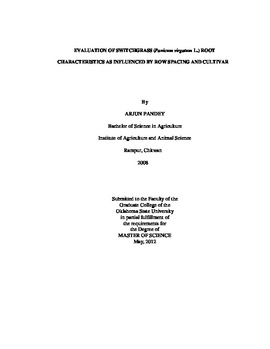| dc.contributor.advisor | Kakani, Vijaya Gopal | |
| dc.contributor.author | Pandey, Arjun | |
| dc.date.accessioned | 2014-04-15T22:06:16Z | |
| dc.date.available | 2014-04-15T22:06:16Z | |
| dc.date.issued | 2012-05-01 | |
| dc.identifier.uri | https://hdl.handle.net/11244/9354 | |
| dc.description.abstract | Switchgrass, a model herbaceous energy crop has high potential for C sequestration from atmosphere and also improves soil quality via its deep fibrous root system. The individual root and the entire root system, various morphological parameters, which are influenced by genetic variability and environmental conditions, have been used as potential indicators water and nutrient uptake. Studies on different root characteristics and their distribution pattern are very limited. Root samples were taken with hydraulic powered core and measurement of root parameters were carried out with an image analysis system (winRHIZO ver. 5.0). The objectives of the study were to 1) evaluate switchgrass root characteristics as influenced by row spacing at peak growth and after senescence. 2) Identify differences for different root characteristics among switchgrass cultivars at peak growth and after senescence. 3) Determine the correlation between switchgrass above and below ground root biomass. Wider row spacing (76.2 cm) had higher root length density (RLD) and root weight density (RWD) by the end of the growing season (December) while narrow spacing (19.05 and 38.1 cm) had increased RWD though lower in RLD. RWD and average diameter were found higher due to the decrease in fine roots proportions by the end of the growing season. Higher RLD was observed in upland cultivars than in low land cultivars. Similarly, RWD and average diameter increased in all layers of soil profile by the end of growing season. Above ground biomass of upland cultivars was positively correlated with below ground root biomass but no such relationship was observed among lowland cultivars. In conclusion, switchgrass demonstrated plasticity of root growth in response to row spacing. Lowland cultivars have higher above ground biomass while upland cultivars have higher root biomass. Root biomass is highly influenced by the distribution of fine roots. | |
| dc.format | application/pdf | |
| dc.language | en_US | |
| dc.publisher | Oklahoma State University | |
| dc.rights | Copyright is held by the author who has granted the Oklahoma State University Library the non-exclusive right to share this material in its institutional repository. Contact Digital Library Services at lib-dls@okstate.edu or 405-744-9161 for the permission policy on the use, reproduction or distribution of this material. | |
| dc.title | Evaluation of Switchgrass (Panicum virgatum L.) Root Characteristics as Influenced by Row Spacing and Cultivar | |
| dc.type | text | |
| dc.contributor.committeeMember | Warren, Jason | |
| dc.contributor.committeeMember | Wu, Yanqi | |
| osu.filename | Pandey_okstate_0664M_12105.pdf | |
| osu.college | Agricultural Sciences and Natural Resources | |
| osu.accesstype | Open Access | |
| dc.description.department | Department of Plant and Soil Sciences | |
| dc.type.genre | Thesis | |
